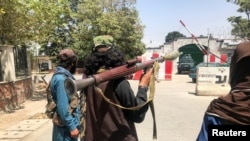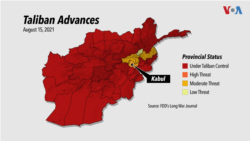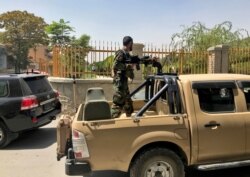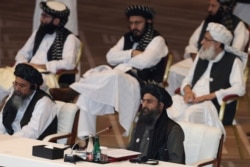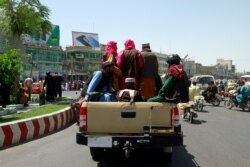The rapid Taliban offensive across Afghanistan that culminated Sunday with the flight of Afghan President Ashraf Ghani was meticulously planned and executed with ruthless efficiency, say Western military experts.
And they note the Islamist militants appeared to have learned from their tactical mistake in the mid-1990s, when they overran Kabul before having secured the north of the country, allowing opponents to form a Northern Alliance opposition.
This time around, Taliban commanders have been much more methodical, building up momentum by securing outlying districts, securing the main border posts with neighboring Pakistan and Iran, then moving on to regional capitals, and leaving Kabul for last after seizing Mazar-e-Sharif, Afghanistan’s fourth largest city and the onetime stronghold of the Northern Alliance.
The Northern Alliance helped U.S.-led forces topple the Taliban in 2001, after the September 11th terror attacks on the United States.
A pair of veteran warlords had pledged to assist the Afghan army in protecting Mazar-e-Sharif, but as with many other provincial capitals, a strong defense did not materialize.
Demoralized Afghan army forces shrank away or surrendered. The pro-government militias downed their weapons or switched sides after warlords Abdul Rashid Dostum and Ata Mohammad Noor fled abruptly, Abas Ebrahimzada, a local lawmaker, told the Associated Press.
“The Taliban’s success has not happened by chance,” said Tim Willasey-Wilsey, a former British diplomat and now a visiting professor at King’s College London. “It is clearly the fruit of preparation and planning. Above all, they have learnt from the experience of 1994 to 1996 when they eventually took Kabul but failed to capture the north,” he wrote in a commentary for the Cipher Brief, an online subscription-based conversation site connecting private and public sector security professionals.
Western diplomats say Abdul Ghani Baradar, the Taliban’s political chief, and Mullah Yaqoob, son of the Taliban's founder Mullah Omar, who leads the group’s military commission, were among the main strategic planners behind the offensive, likely plotted over years.
Baradar is a veteran leader and was largely brought up in Kandahar -- the Taliban’s birthplace. His military experience goes back even before the formation of the Taliban — he fought against the Russians in the 1980s. After the Russians left, he partnered with Mullah Omar, his brother-in-law, to set up the Taliban movement of young “purist” Islamic scholars with the backing of Pakistan’s Inter-Services Intelligence agency. With the same rapidity seen in recent weeks, the Taliban in 1996 seized power after capturing a series of provincial capitals.
Baradar was detained by Pakistani security forces in 2010 at the request of the Obama administration but freed three years ago, again at the request of the Trump administration, to lead the Taliban’s negotiation team in Qatar, where a partially secret deal was struck in February 2020 outlining the principle of a U.S. withdrawal.
Some critics of the Biden’s administration’s decision to withdraw argue that the negotiations in Qatar, which since became deadlocked when it came to peace talks between the Afghan government of Ashraf Ghani and the Taliban, was just seen by the Islamist militants as a staging post to their sweeping into power. They noted the discrepancies between what the Taliban were saying in Doha, during ultimately fruitless exchanges, and what the group’s fighters were doing.
And it may have lulled Washington into believing that the Taliban were prepared to reach some political accommodations with their Afghan adversaries. Others see the talks as a contributing factor in the demoralization of the Afghan government and its 350,000-strong security forces, trained and equipped at huge cost by the U.S. and Western coalition allies.
“The Taliban’s advances can be attributed primarily to the erosion of morale and cohesion among the government’s security forces and political leadership,” according to Laurel Miller and Andrew Watkins of the International Crisis Group, a Brussels-based research group.
In a commentary Saturday, they noted that since May, while talks in Doha were under way, the Taliban “drove security forces from more than 200 of the country’s roughly 400 districts, in many instances without much fighting.”
They added, “The first districts to fall were home to poorly resourced and surrounded small bands of government forces, and the Taliban reached out to many via local elders, persuading them to leave their posts without fighting. With each new advance, a sense of momentum grew among the insurgents’ own rank and file but also among local communities. Over recent months, the Taliban actively engaged local communities throughout the country with a mixture of disinformation, threats, targeted violence and promises of clemency, even in some cases for troops and civilian officials.”
Back in June, Andrew Wilder of the United States Institute of Peace, a Washington-based independent institute founded by the U.S. Congress, was warning the decision to withdraw U.S. forces “without a cease-fire or a framework for a political agreement between the Taliban and the government caught Afghans and regional countries by surprise,” adding the Taliban was “capitalizing on the moment to seize dozens of districts and project an air of confidence.”
As U.S. troops started the drawdown, psychological and military momentum shifted to the Taliban. After a trip to Kabul, he cautioned, “Afghan security forces suffer from low morale and frequent changes in leadership and supply shortages caused by poor planning and the withdrawal of international air support.”
Western military officials say the failure by the Ghani government to shape a strategic defense plan, give clear instructions to units, and even to supply with any consistency, further corroded the confidence of the Afghan military. And the speed of the Taliban offensive disoriented them as did suddenly being cut off from close U.S. air support, which a lot of their training focused on.
Analyst Jack Watling of the Royal United Services Institute, a British defense-focused research group, told the BBC: “Soldiers are often sent to areas where they have no tribal or family connections. One reason why some may have been so quick to abandon their posts without putting up a fight.”
“I think the demoralization factor was predictable but not factored in enough by the decision-makers in Washington,” a senior British military official told VOA on the condition of anonymity.
“I am not surprised that much by the caving in of Afghan forces — with the notable exception of some special forces — or of local pro-government militias throwing in the towel or even swapping allegiances. If you look at what happened as Soviet forces started their withdrawal in the 1980s, something similar happened with militias and their leaders making their calculations and turning against the government as they sensed the central government was doomed,” he added.
Judging by Taliban actions the past few days, the group’s leaders may have factored into their end game calculations that tribal leaders and some veteran warlords would switch sides. And there are signs that the Taliban leadership has been holding secret talks with key local leaders for weeks to assure them that local political and administrative arrangements can continue as much as before as long as overall Taliban authority is accepted, say British officials.
In Herat, near the Iranian border, local leaders were quick to side last week with the Taliban, including Kamran Alizai, Herat’s provincial council chief, after little fighting, Local pro-government warlord Ismail Khan also quickly submitted and was dispatched by the Taliban to Kabul Friday as a go-between for talks with officials still loyal to the Ghani government, according to local reports.




